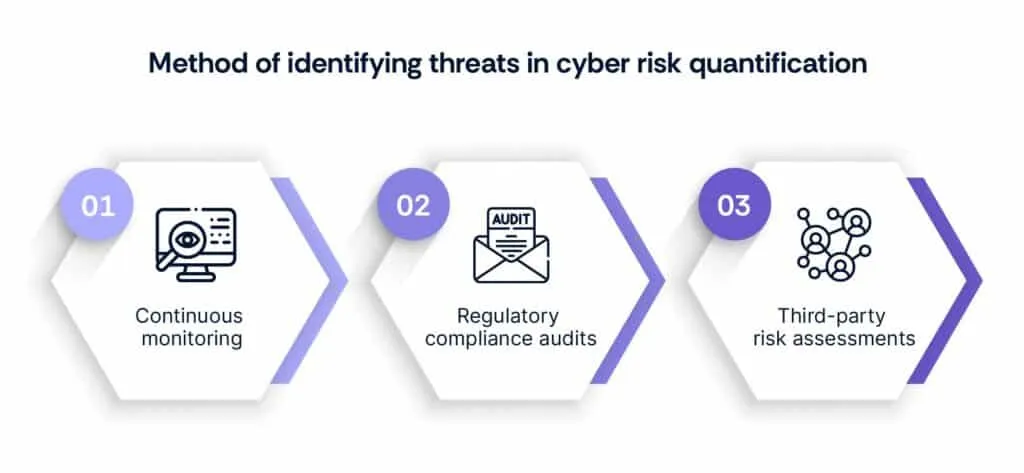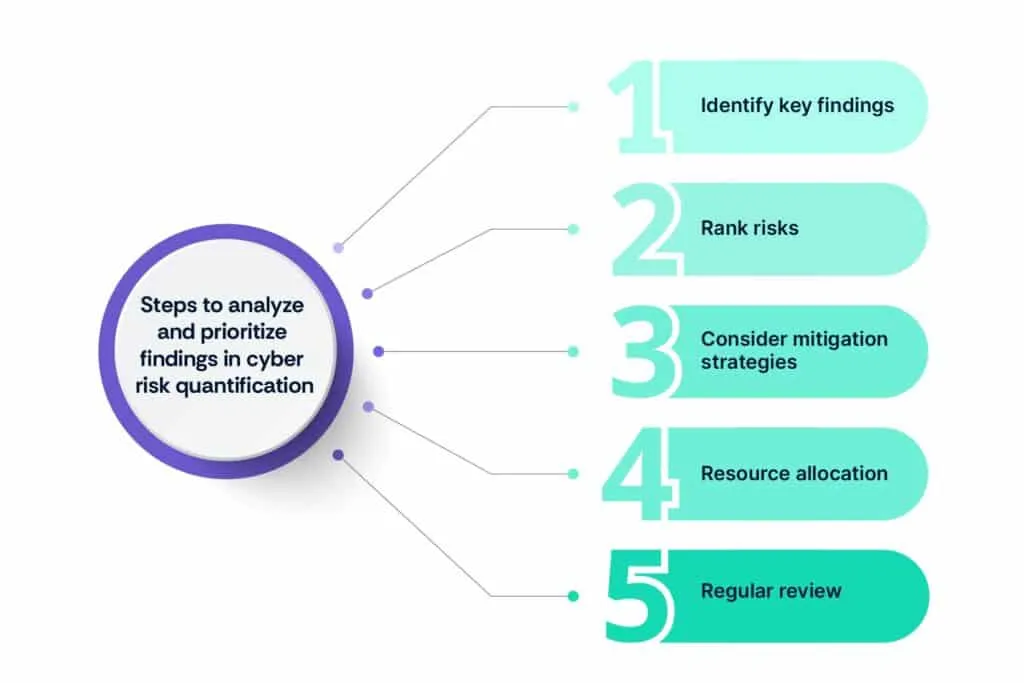How to perform a SWOT analysis for cyber risk quantification

Cyber Risk Quantification (CRQ) is the process of evaluating and measuring the potential financial impact and exposure of cyber risks to an organization in terms that are relevant to its business operations. This involves assessing vulnerabilities, threats, and their likelihood of occurrence to prioritize mitigation efforts effectively. There are various cyber risk quantification methods, including FMEA, event tree analysis, and SWOT analysis. In this article, we will concentrate on SWOT analysis as a cyber risk quantification method.
1. Understanding cyber risk quantification
Cyber risk quantification involves calculating the potential financial impact of cyber threats on an organization in terms relevant to its business operations. This process assigns numerical values to assess the impact of cyber events, aiding in decision-making regarding cybersecurity resource allocation and risk management strategies.
It’s crucial for businesses to conduct CRQ to prioritize mitigation efforts effectively, allocate cybersecurity resources efficiently, and understand the potential financial consequences of cyber threats. By quantifying cyber risks, organizations can make informed decisions to strengthen their security posture and minimize financial losses.
1.1 Automation in cyber risk quantification
A cyber risk quantification solution is a comprehensive tool or platform designed to help organizations assess, measure, and manage their exposure to cyber risks in a quantifiable manner. These cyber risk quantification tools typically employ various methodologies, algorithms, and data analysis techniques to evaluate the potential financial impact of cyber threats on an organization’s operations and assets.
Key features of a cyber risk quantification software may include:
- Risk assessment: Conduct thorough assessments of an organization’s cybersecurity posture, including vulnerabilities, threat landscape, and potential impact on business operations.
- Financial impact analysis: Estimating the potential financial losses associated with cyber incidents, such as data breaches, system outages, or regulatory fines.
- Scenario modeling: Simulating different cyberattack scenarios to understand their potential impact on business operations and financial outcomes.
- Risk prioritization: Prioritizing cyber risks based on their severity, likelihood of occurrence, and potential financial impact to focus mitigation efforts on the most critical areas.
- Decision support: Providing actionable insights and recommendations to help organizations make informed decisions regarding cybersecurity investments, resource allocation, and risk management strategies.
Overall, a cyber risk quantification solution aims to empower organizations to proactively identify, assess, and mitigate cyber risks, ultimately enhancing their cybersecurity resilience and minimizing the potential impact of cyber threats on their operations and finances.
2. Overview of SWOT analysis
SWOT analysis is a strategic planning tool used to identify and analyze an organization’s internal strengths and weaknesses, as well as external opportunities and threats.
3. Conducting a SWOT analysis for cyber risk
3.1 Identifying strengths

Identifying the internal strengths of an organization related to cybersecurity involves thorough assessment and analysis. Here’s detailed guidance on identifying these strengths:
- Robust infrastructure: Evaluate the organization’s IT infrastructure, including networks, servers, and endpoints, to determine its resilience against cyber threats. Look for redundant systems, encryption protocols, and secure configurations.
- Skilled personnel: Assess the expertise and qualifications of the cybersecurity team. Consider factors such as certifications, training programs attended, and experience in handling various cyber incidents.
- Effective security protocols: Analyze the organization’s security policies, procedures, and controls. Check for measures such as access management, regular security updates, incident response plans, and compliance with industry standards and regulations.
Identifying these strengths provides insight into the organization’s ability to defend against cyber threats effectively and enhances its cybersecurity posture.
3.2 Recognizing weaknesses

To recognize internal weaknesses in cybersecurity preparedness, consider the following tips:
- Outdated technology: Assess the organization’s technology infrastructure for obsolete software, hardware, or unsupported systems. Look for vulnerabilities that may arise due to outdated patches or unsupported applications.
- Lack of employee training: Evaluate the level of cybersecurity awareness and training among employees. Identify gaps in knowledge regarding phishing scams, social engineering tactics, and safe data handling practices.
- Inadequate incident response procedures: Review the incident response plan to ensure it is comprehensive and up to date. Identify any shortcomings in processes for detecting, analyzing, and mitigating security incidents.
Recognizing these weaknesses enables organizations to proactively address them and strengthen their cybersecurity posture.
3.3 Exploring opportunities

To identify external opportunities for enhancing cyber risk management, consider the following strategies:
- Advancements in cybersecurity technology: Stay updated on emerging technologies such as AI-driven security tools, blockchain for data integrity, or cloud-based security solutions. These advancements can offer more robust protection against evolving cyber threats.
- Regulatory changes: Monitor regulatory changes in data protection laws, industry standards, and compliance requirements. Leveraging these changes can help align cybersecurity practices with regulatory expectations and mitigate legal risks.
- Market trends: Analyze market trends related to cybersecurity investments, threat intelligence sharing platforms, or cyber insurance options. Identifying emerging trends allows organizations to adapt their risk management strategies to current industry practices.
By actively exploring these external opportunities, organizations can enhance their cyber risk management practices and stay ahead of potential threats.
3.4 Identifying threats

To identify external threats effectively, consider the following methods:
- Continuous monitoring: Implement systems for continuous monitoring of cyber threats, including threat intelligence feeds, security information and event management (SIEM) solutions, and penetration testing.
- Regulatory compliance audits: Conduct regular audits to ensure compliance with industry regulations and standards. This helps identify potential regulatory non-compliance risks and ensures that appropriate measures are taken to address them.
- Third-party risk assessments: Regularly assess the cybersecurity posture of third-party vendors and partners. Evaluate their security practices, data handling procedures, and compliance with security standards to identify vulnerabilities in third-party relationships.
By employing these methods, organizations can proactively identify and mitigate external threats, safeguarding their assets and data from potential cyberattacks.
4. Analyzing and prioritizing findings

To effectively prioritize actions for cyber risk mitigation and management based on the SWOT analysis, follow these steps:
- Identify key findings: Review the SWOT analysis to identify the most critical strengths, weaknesses, opportunities, and threats related to cybersecurity. Focus on factors with the highest impact on the organization’s security posture.
- Rank risks: Prioritize risks based on their severity and likelihood of occurrence. Assign a risk score or rating to each identified risk to quantify its potential impact on the organization.
- Consider mitigation strategies: Evaluate potential mitigation strategies for each identified risk. Determine which actions can address multiple risks effectively and efficiently.
- Resource allocation: Allocate resources based on the prioritized risks. Invest resources where they can have the most significant impact on reducing cyber risks and enhancing cybersecurity resilience.
- Regular review: Continuously monitor and review the effectiveness of mitigation efforts. Update the prioritization of actions as new threats emerge or the organization’s risk landscape evolves
5. Implementation and continuous improvement

Implementing action plans derived from the SWOT analysis requires a structured approach:
- Action plan development: Based on identified strengths, weaknesses, opportunities, and threats, develop specific action plans to address each aspect. Assign responsibilities, set timelines, and define measurable objectives for each action.
- Prioritization: Prioritize action items based on their impact and urgency. Focus on addressing critical weaknesses and leveraging significant opportunities first to maximize effectiveness.
- Resource allocation: Allocate resources effectively to support the implementation of action plans. Ensure that the necessary budget, manpower, and technology are available to execute the planned initiatives.
- Monitoring and evaluation: Establish processes for ongoing monitoring and evaluation of the implemented action plans. Regularly assess progress against predefined metrics and adjust strategies as needed to stay aligned with organizational goals.
- Continuous improvement: Foster a culture of continuous improvement by encouraging feedback and learning from experiences. Periodically reassess the SWOT analysis to identify emerging trends, evolving risks, and new opportunities. Use insights gained to refine action plans and enhance organizational resilience.
By following these recommendations, organizations can effectively implement action plans derived from the SWOT analysis and establish robust processes for ongoing monitoring, reassessment, and continuous improvement of their cybersecurity posture.
Conclusion
In conclusion, Cyber Risk Quantification (CRQ) is vital for organizations to effectively navigate cybersecurity threats. Techniques like SWOT analysis offer invaluable insights into strengths, weaknesses, opportunities, and threats. By understanding these factors, organizations can prioritize mitigation efforts, allocate resources efficiently, and fortify their security posture.
SWOT analysis aids in identifying internal strengths, weaknesses, external opportunities, and threats related to cybersecurity. Through meticulous assessment, organizations can develop actionable insights to address vulnerabilities, capitalize on opportunities, and mitigate risks effectively.
Implementing action plans derived from SWOT analysis requires a structured approach, including plan development, prioritization, resource allocation, monitoring, evaluation, and continuous improvement. This methodology establishes robust processes for ongoing monitoring, reassessment, and enhancement of cybersecurity posture.
In summary, CRQ, particularly through techniques like SWOT analysis, empowers organizations to proactively manage cyber threats, minimize financial losses, and navigate the evolving threat landscape with confidence and resilience.
Ready to fortify your organization’s defenses against cyber threats? Schedule a demo with Scrut for Risk Management today and take proactive steps towards safeguarding your digital assets. Protect your business with confidence. Get started now!
FAQs
1. What is SWOT analysis, and how does it relate to cyber risk quantification?
SWOT analysis is a strategic planning tool used to identify and analyze an organization’s internal strengths and weaknesses, as well as external opportunities and threats. In the context of cyber risk quantification, SWOT analysis helps organizations identify strengths and weaknesses in their cybersecurity posture, as well as external opportunities and threats in the cyber landscape.
2. How does SWOT analysis help organizations in managing cyber risks?
SWOT analysis provides organizations with insights into their cybersecurity strengths, weaknesses, opportunities, and threats. By understanding these factors, organizations can develop targeted strategies to address vulnerabilities, capitalize on opportunities, and mitigate risks effectively.
3. What are some examples of strengths and weaknesses in cybersecurity identified through SWOT analysis?
Examples of strengths could include robust cybersecurity measures, skilled cybersecurity personnel, and effective incident response protocols. Weaknesses may include outdated technology, lack of employee training, and inadequate incident response procedures.


















